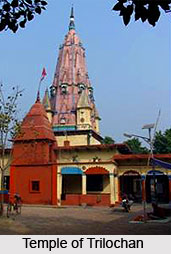 The temple of Trilochan or the Three eyed is located in Varanasi. It is an ancient temple and is regarded as very sacred by the pilgrims. It is visited by many devotees form far off places and is regarded as very holy.
The temple of Trilochan or the Three eyed is located in Varanasi. It is an ancient temple and is regarded as very sacred by the pilgrims. It is visited by many devotees form far off places and is regarded as very holy.
Legend of Temple of Trilochan
The Temple of Trilochan is associated with many miracles and legends. According to a legend, on one occasion, Lord Shiva was wrapt in meditation. He was visited daily by Lord Vishnu, who always brought with him a thousand separate flowers. With these flowers he scarified to the Shiva in the act of worshipping him. One day as usual Vishnu had brought his thousand flowers and placed them ready for sacrifice. At this time suddenly his attention was drawn off from them for a short time. Taking advantage of the situation Shiva quietly took away one of the flowers. As Vishnu was ignorant of the circumstance, he took the flowers to begin his worship. He began offering his flowers one at a time, and counting the number offered. To his surprise on arriving at the nine hundred and ninety-ninth, he found that one was missing. He had no clue for the reason behind it. However, it was necessary on his part to complete the sacrifice which he had begun. He thus removed an eye from its socket, and offered it instead. On applying the eye to the forehead of the idol, it adhered to the spot on which he placed, it. Shiva immediately began to see with it, and from that time forwards possessed three organs of vision.
There is another tale associated with the temple and the third eye of Lord Shiva. The devotees here believe that the idol of the Lord which is worshipped in his temple, have passed through the seven patalas or subterraneous regions and finally made its home in this place. Parvati, the wife of Lord Shiva, was, at this time, looking for him but could not find him. Shiva, with his third eyes, that is the eye of reflection, distinguished from his other two eyes, which are merely eyes of observation, could perceive her. It is said that this temple is located at the confluence of the three rivers, the Ganges, the Jumuna, and the Saraswati. Moreover, three notable deities are spoken of as residing here, Saraswateswar, Jamaneswar, and Nirbuddheswar. The first two idols exist here. They can be traced in the enclosure of the temple. The last deity is installed in a separate temple that is located at a short distance from the Trilochan temple. Earlier all the three idols were worshipped here in this place; and were referred to in the Kasi khanda.
The devotees visiting the temple believe that by performing religious ceremonies in the Trilochan temple is regarded to be very holy. The blessings of the Lord can also be received by worshipping the idols.
Architecture of Temple of Trilochan
Temple of Trilochan is located in the midst of a quadrangle that has been built recently. It was constructed by Nathu Balk. There are several idols installed on both sides and in front of the high walled enclosure. Few of the idols are very small and have been placed in separate shrines in groups of five, ten, twenty or more. Two temples have been constructed on the left side. One of the temple is surmounted by a low spire while the other one by a small dome. The duties have been installed on the floors of the temple. Few of them are also inserted into the walls. The vahana or the mount of these deities are also installed in the temples. On the right hand side is a series of shrines occupied by assemblages of idols. There is another image of a deity known as Kot Lingeswar that stands apart from all the shrines. It is made of stone, and is three feet high above its base, and ten inches or a foot in thickness. In the south west direction a peepul tree grows. Here an idol of the monkey god Lord Hanuman can be seen. The idols of Lord Ganesha and Sitala known as the goddess of small pox are carved on the walls here. Another beautiful temple can be seen standing in the middle of the enclosure in front of the porch of the Trilochan temple. Each division is open on its three sides. The temple has an assortment of its idols that look stunning.
The porch of the Trilochan temple is painted in red colour. It is supported by eight pillars, four in front, and four attached to the wall behind. Its roof is embellished with attractive pictures on the walls. A bull or a Nandi has been carved directly opposite to the entrance of the temple. It is made of white marble and is in a recumbent posture. Two bells are suspended in the porch, which are struck by the worshippers upon entering the temple. The wall of the temple, adjoining the porch, displays many objects. A figure of Lord Ganesha can be seen here in a niche in the wall on the left. It is made of white marble. Neat it is a painting, representing Fanak Shah, the Guru or spiritual guide of the Sikh. race. In a niche on the right are two black figures of Lord Vishnu, and his wife Goddess Lakshmi.





















